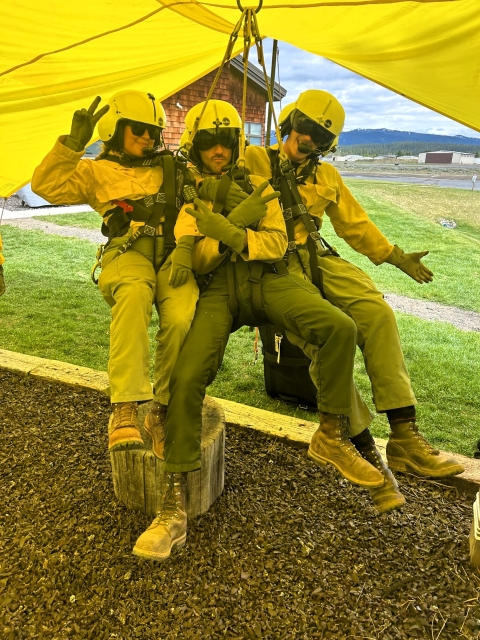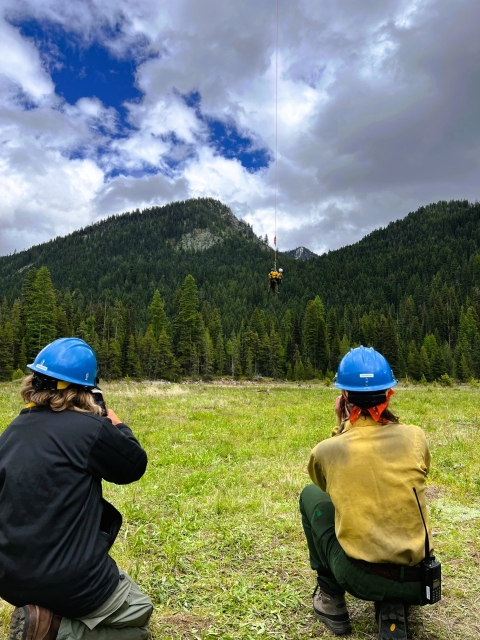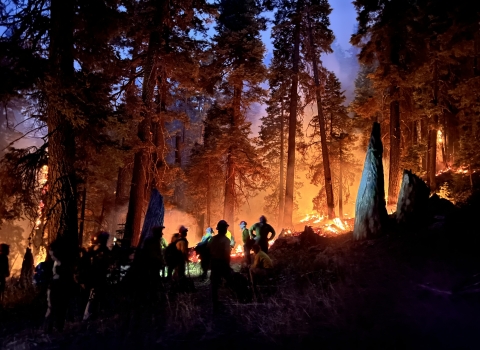Dangling from a rope 150 feet below a helicopter isn’t for the faint-hearted; but for some, being suspended in the air is an exhilarating experience. Brandon Williams, a wildland firefighter apprentice at San Luis National Wildlife Refuge Complex in California, lives for such a thrill. In March 2024, he pursued the challenge of becoming a helitack crewmember — a firefighter specialized in wildland fire helicopter response.
The Wildland Firefighter Apprentice Program is designed to develop future leaders in wildland firefighting. Think of it as essentially an all-inclusive package to a wildland firefighting career, but it’s no vacation. Apprentices complete 3,000 hours of paid, on-the-job training while sampling a variety of roles in wildland firefighting. In addition to training at their home unit, apprentices are encouraged to seek temporary assignments with other wildland fire crews across the country, in positions that suit their career interests and goals.
We asked Williams to tell us about his experience trading a wildland fire engine for a helicopter while working on a helitack crew this year.
Q: Where are you currently working?
Since the spring I have been working with the Teton Interagency Helitack Crew in Wyoming. The crew consists of 27 firefighters and two Type 3 helicopters Type 3 helicopters
Type 3 helicopters have a higher cruise speed than other large wildland fire helicopters and can get to the scene of a wildfire faster. Type 3 helicopters can carry four to five firefighters at a time and use a 180-gallon water bucket.
Learn more about Type 3 helicopters available for wildland fire response. Our helibase is the Jackson Hole Airport. We are an interagency crew, so our home area of response covers both the Bridger-Teton National Forest and Grand Teton National Park.
Q: What fire assignments have you responded to since starting your detail with Teton Interagency Helitack?
Prior to the start of wildfire season, we were busy assisting on interagency prescribed burns throughout the Great Basin. The Great Basin includes Nevada, Utah, southern Idaho and parts of Wyoming and Arizona. Our job— aerial prescribed fire operations—is to strategically use the helicopter to ignite ground vegetation with a plastic sphere dispenser (PSD) or fire with a helitorch helitorch
A helitorch is an aerial ignition device hung from, or mounted on, a helicopter to disperse ignited lumps of gelled gasoline. A helitorch is used for backfires, burnouts or prescribed burns.
Learn more about helitorch system.
We have a large crew, so now that wildfire season has begun, we can assign a crew to respond to wildfires on the ground in addition to fully staffing the helicopter. Most recently, we spent 10 days at the McCall Smokejumper Base in Idaho completing Short-Haul Academy and becoming certified short-haulers!
Q: What is short-haul, and what’s the training like?
Short-haulers are specialized helicopter crew members used mostly in medical emergencies or during search-and-rescue operations. The short-haul crew is very unique.
Short-hauling is a transportation technique used to deliver medical supplies or extract patients from hazardous environments. Trained personnel are lowered from a line suspended below a helicopter, when landing sites are limited or when time is of the essence. After assessing the scene, we load our patients in a rescue litter or hammock-like sling for a quick extraction via helicopter to the nearest medical care.
Following short-haul training, our crew is qualified for medical extractions. Just recently, the use of short-haul during firefighting operations was approved. It is exciting to spearhead this new firefighting tool!
Q: Short-hauling operations sound exciting, but also very technical. Was the training different than what you expected?
I didn't have much aviation experience when I started with the Teton Interagency Helitack Crew. I have been so impressed with the helicopter pilots. I had a chance to watch one of our pilots earn his short-haul certification. Annually, pilots are subjected to a grueling four-stage test where they must show proficiency in everything from flight skills in mountainous terrain to equipment installation and emergency procedures. Finally, they must demonstrate control and precise placement of a weighted load that simulates carrying people and rescue supplies. Watching the pilots showcase their talent and technical skills was amazing. It gave me a sense of relief knowing my life is in their hands!
Q: How do you feel now that you are embedded with the helitack crew and have specialized qualifications?
I don't think I've ever had this much fun in my entire life! I will never forget the thrill of successfully carrying out my first solo short-haul! Going through this experience and learning something so challenging has created a bond with my teammates akin to family.
Additionally, my training with this helitack crew has made me the only certified short-hauler in the U.S. Fish and Wildlife Service wildland fire program! I hope this is just the beginning of our participation in this small, but very talented community within wildland fire air operations.
Q: What made you seek out a helitack crew experience as part of your apprenticeship?
I wanted to expand my scope in wildland fire aviation. I have flown on helicopters for firefighter crew transport in the past but was always curious to learn more. In 2023, while on a fire assignment in Virginia, I met the fire management officer for Grand Teton National Park, who oversees the Teton Interagency Helitack Crew. I asked him if I could join the crew as part of my second year in the apprentice program, and he worked with my U.S. Fish and Wildlife Service supervisors to make it work.
A prescribed burn is the controlled use of fire to restore wildlife habitat, reduce wildfire risk, or achieve other habitat management goals. We have been using prescribed burn techniques to improve species habitat since the 1930s.
Learn more about prescribed burn at his home unit of San Luis National Wildlife Refuge Complex.
I could not have landed at a better place than with the Teton Interagency Helitack Crew. They have been so kind and supportive of me since I arrived here. From the top down, they are great people and great firefighters. Becoming close to everyone here has probably been my favorite part of this experience; I have loved every second of it.
Q: What would you tell prospective wildland fire apprentices about your experience in the Wildland Firefighter Apprenticeship Program?
The Wildland Firefighter Apprenticeship Program is what you make of it. This program provides you opportunities to go anywhere in the country, on any type of crew you want. If you take the time to network and promote yourself, you can build the skills and qualifications to create your dream career in wildland fire.
My supervisors and coworkers at my home station have all been so supportive and key to making this apprenticeship the best experience for me. This program has allowed me to build incredible skills that I will bring back to San Luis National Wildlife Refuge. Every day I am becoming more well-rounded and more confident in my abilities as a wildland firefighter.








